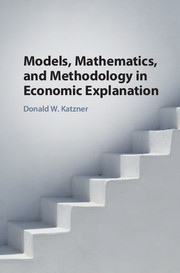Book contents
- Frontmatter
- Dedication
- Contents
- Preface
- Introduction
- 1 Science and Economics
- 2 Economic Models and Explanation
- 3 The Stages of Model Building in Economics
- 4 Models and Mathematics
- 5 Models and Measurement (or Lack Thereof)
- 6 Issues Relating to the Construction of Models from Scratch
- 7 An Example: The Efficiency of Organizational Forms
- 8 The Implicit Assumption Requirements of Later-Stage Model Building
- 9 Ordinality and the Adequacy of Analytic Specification
- 10 Categories of Models
- 11 Conclusion
- Index
8 - The Implicit Assumption Requirements of Later-Stage Model Building
Published online by Cambridge University Press: 26 October 2017
- Frontmatter
- Dedication
- Contents
- Preface
- Introduction
- 1 Science and Economics
- 2 Economic Models and Explanation
- 3 The Stages of Model Building in Economics
- 4 Models and Mathematics
- 5 Models and Measurement (or Lack Thereof)
- 6 Issues Relating to the Construction of Models from Scratch
- 7 An Example: The Efficiency of Organizational Forms
- 8 The Implicit Assumption Requirements of Later-Stage Model Building
- 9 Ordinality and the Adequacy of Analytic Specification
- 10 Categories of Models
- 11 Conclusion
- Index
Summary
The concept of model building in explanation as contemplated here and illustrated in the previous chapter has been described in Section 3.1 to include five procedural steps in the process of model construction: (i) formulate an initial image, (ii) transform it into a model, (iii) operationalize the model, (iv) test the model when appropriate, and (v) evaluate the explanatory significance of the model, i.e., its cogency, relevance, and usefulness. It has also been suggested (Section 3.2) that in many instances of model building economists tend to ignore stages (i) and (ii) and proceed directly to stage (iii). But skipping over stages (i) and (ii), it has been argued, has serious consequences, namely, an impairment of the ability to judge the relevance and usefulness of the model under consideration. Several informal examples have been given to indicate how beginning model construction at stage (iii) can hide important assumption content that might lead the investigator to reject and discard the model on the grounds of impertinence and inadequacy. One of these illustrations was the starting of the construction of the model of consumer demand at stage (iii) with the secondary assumption of an additive utility function. It was asserted in that case (the proof has been delayed until Section 8.2 below) that additivity implied that the preference ordering underlying the utility function had the property that the individual's preference for any quantity of any commodity was independent of the quantities of all other commodities – a characteristic of individual preferences that might not seem realistic and suitable for the purpose at hand.
This conclusion points to a general principle of some importance that has been brought out earlier and is worth emphasizing again: To a considerable extent, the ability of a model to relate and explain rests on the nature of the stage (iii) secondary assumptions and what they imply at the nearer-to-reality stage (i) and stage (ii) levels. Thus model building that neglects stages (i) and (ii), and begins at stage (iii) leaves important questions concerning its acceptability somewhat in doubt.
The purpose of this chapter is to investigate in more formality and greater detail the nature of some of the assumptions at the level of stage (ii) that are implicitly introduced, that is, implied though not explicitly stated, by certain secondary assumptions when starting at stage (iii) with an operational model.
- Type
- Chapter
- Information
- Models, Mathematics, and Methodology in Economic Explanation , pp. 176 - 191Publisher: Cambridge University PressPrint publication year: 2017



